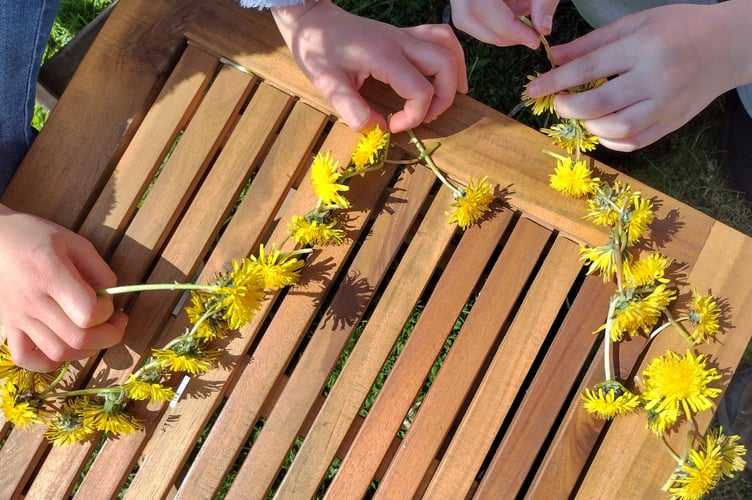What can be better than sharing your wonder and enthusiasm for nature with a keen and curious group of children? Not much, except doing it on a perfect, sunny, spring day. It was Wild About Loddiswell’s very first ‘Bugs, Moths and other Beasties Family Day’ and I was ready and excited!
9.45am and suddenly, the parish church entrance was crammed with children, adults, buggies and a baby. After finding out everyone’s names, I asked the youngsters to remind their grown-ups about how to stay safe in the countryside…and then we were off! Sixteen children plus mums, dads and grannies, sandwiched between WAL leaders, Liz Montague, Phil Comelio and Sarah Butler in their high-vis jackets, made their way through the village and along to Ham Farm orchard for the first moth trap reveal of the year.
In 2024, a successful grant bid to the Wild About Devon Fund enabled us to purchase a splendid moth trap which could be run off a car battery, making it much more versatile to set up in suitable locations. However, on the day before our event, a brisk easterly breeze posed a challenge. Thankfully, as the evening light dwindled, Phil, Liz and I discovered a high spot against an orchard hedge where there was shelter. We hung the moth trap in a nearby tree, conveniently protected with a tree-guard, keeping it above of reach of grazing sheep. Illuminated with its eerie ultra-violet glow, we left the trap to the mysteries of night, wondering what morning would reveal.

And, as our party approached the slope through the orchard, we could see two people at the trap already. The first was Phil Dean, a friend, fellow volunteer at Devon Wildlife Trust’s Andrews Wood, and enthusiastic moth expert; the second was Gordon Waterhouse, our very own Local Celebrity Naturalist!
Phil had already captured several moths found close to the trap. Handing the little see-through pots around, he told the children their names: Oak Beauty, Early Thorn, Hebrew Character and March Moth. Gordon encouraged the children to think of their own names to describe the moths, prompting one of the boys to list Chicken Wings and Cheeseburger as his preferred options! Some of the girls agreed that Dry Leaf was a much better descriptive name for the Early Thorn as that is exactly what it resembles. Unzipping the trap and carefully extracting the egg box cartons inside, we added Small Quaker, Common Quaker and Knotgrass to our moth list, the children fascinated to see each different species. Finally, we gathered along the hedgerow and carefully released our captives. Then it was off to Ham Farmhouse where owners and great WAL supporters, Peet and Carl, had refreshments waiting for us in the garden. This was definitely a highlight of the morning, with home-pressed apple juice, Peet’s delicious cakes and some perfect grassy slopes for the children to roll down and play on.
-Fiona-van-Es.jpeg?width=752&height=500&crop=752:500)
Refreshed and regrouped, we carried on our invertebrate hunt, with a sheet stretched out below a bush or a small tree, and the branches above being given a series of sharp blows with a stick. A few small spiders, ants, flies and one green caterpillar were found; not much but to be expected as it is still early in the year, which is why we plan to run more of these events, one mid-summer and another in autumn. As the morning session ended, it was brilliant to hear the enthusiasm in both children and adults to join us again.
Birthday parties, sports clubs and other commitments meant that our afternoon session was quieter with just five children. However, attracted by the generous support of the parish church providing more delicious refreshments, we had quite a few more adults, enjoying the warm sunshine outside and wildlife displays inside.

Sweep-netting was our first activity, with nets, bug pots and identification charts lent to us by Devon Wildlife Trust’s Wilder Communities team (a brilliant scheme for community groups like ours). Again, only a few spiders, flies and ants but the children loved learning the technique of sweeping with the special flick at the end to prevent creatures escaping; also, not to use them to catch butterflies as these nets could damage their wings.

Our final session was to create places of shelter and refreshment for wildlife so together we filled a shallow dish with pebbles and water, placing it outside the church for bees and other insects; filled some terracotta flower pots with dry moss and semi-buried them on the sunny side of a tree stump in the churchyard and finally, tied together bundles of bamboo lengths to take home to their gardens for mason bees to make homes inside.
Happy children, happy leaders: a good wildlife-focused community day all round.




